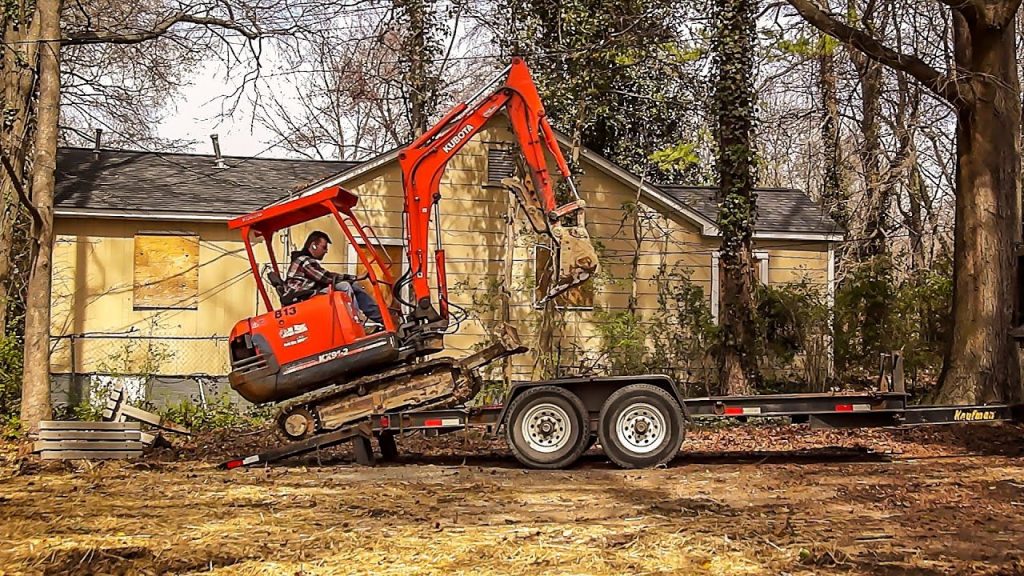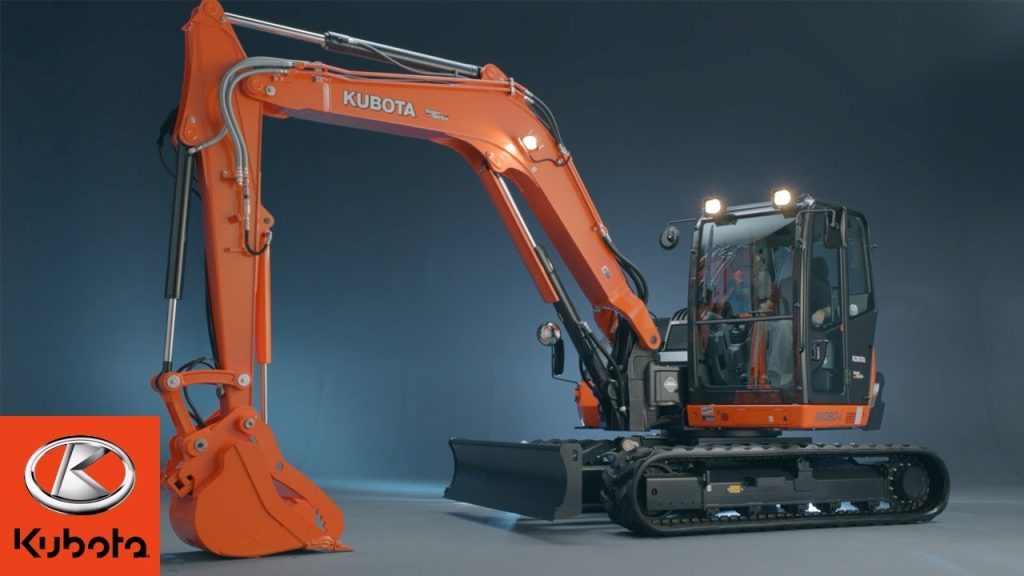Troubleshooting a Kubota Excavator is relatively simple. These machines are very powerful and well built, they don’t require much attention to keep them up and running. The biggest surprise when it comes to excavator repair is how little they break down.
Kubota excavator machine arm/boom movements are stiff or stuck
If your kubota excavator arm/boom movements are stiff or stick. You will need to remove the main valve and clean it up. The valve is located under the cab and you need to remove 2 bolts from the bottom plate, then remove 3x 10mm bolts from the top plate.
The main valve is a spool type and there is only 1 O-ring on the end of it. It is a good idea to replace this O-ring first and keep the old one for future reference if you ever need it again!
When assembling make sure all hoses are connected properly before installing new O-rings in position:
1. Install new O-ring on end of spool
2. Install spool into housing
3. Install cylinder hose
4. Install control lever hoses
5. Reinstall top plate
6. Reinstall bottom plate
7. Fill reservoir with hydraulic fluid
8. Start engine
9. Move levers back forth until air has been bled out of system

Kubota excavator machine does not move or has weak movement
1. The hydraulic pump is broken and the oil circuit is blocked.
2. The solenoid valve is damaged and the oil circuit is blocked.
3. The spool valve is damaged, the electromagnetic reversing valve is damaged, the hand valve is not adjusted properly, or the pipeline leakage causes insufficient pressure supply and insufficient flow rate.
4. The pressure relief valve fails to drop pressure or leaks out of oil, and the pipeline leaks oil, causing insufficient pressure supply or insufficient flow rate.
5. The gear pump gear wear or damage, causing insufficient flow rate or pressure drop; or gear pump suction pipe leakage, causing insufficient fluid level or air suction; or gear pump gland damage, resulting in excessive leakage of oil; Or the gear pump suction pipe or suction filter clogging caused by air suction; or gear pump drive shaft bearing wear (or damage), resulting in poor rotation of gear pump drive shaft; Or gear pump drive shaft spline wear caused by poor power transmission; Or gear pump drive shaft keyway worn out of elasticity caused by poor power transmission.
kubota excavator Backfill blade is stiff or slow
The backfill blade is stiff or slow to respond. This can be caused by a number of things but the most common cause is worn or broken bushings. If a bushing is worn enough, it will allow the pin to move in and out, causing the blade to be stiff. If a bushing is broken, it will allow the blade not to move at all. Be sure to check for any debris which may have been picked up by the blade that could be restricting its movement.
To replace bushings, you will need a hydraulic press. Use the correct size socket to drive out the pin and then press out the old bushing. To install a new bushing, first lubricate the inside of the bushing and then use a socket and hammer or press to drive it in. The pin can now be installed.
1. Check the hydraulic system for any restrictions in the couplings, measuring valves or filters.
2. Use a flow gauge to measure the flow into the backfill blade cylinder. The flow should be at least 2 gallons per minute. If there are restrictions, check the pump and drive motor for damaged couplings, valves, hoses and cylinders.
3. Check for broken welds on the backfill blade frame and for bent or broken cylinder rods or linkages.
kubota excavator No pressure from auxiliary hydraulics, hammer or rotation circuit
I have a Kubota KX91-3 super series excavator. I had an issue with the main boom cylinder loosing pressure making it very hard to operate. I took the main boom cylinder off and rebuilt it and greased the pin & bushings on the boom.
When I reassembled it, everything was working fine except I have no pressure from any of the auxiliary hydraulics, hammer or rotation circuit. The bucket still works fine but nothing else does.
I checked all of the hoses and did not find any kinks or leaks anywhere that would make sense.
I am new to this forum so I am sorry if I have posted this in the wrong place.
I had the same problem on my KX71-3 and ended up putting a new pump in it. The pump was bad and the valves were not sealing properly due to the pump not producing enough pressure.
kubota excavator starts but is slow to operate and lacks power
I have a Kubota KX 121-3 mini excavator that has plenty of battery power when starting. However, it runs very sluggish. It will not go up a grade and struggles to move compared to how it should. When it is working as it should, it will go up a grade with ease and move very quickly.
I have replaced the fuel filter and even tried adding new fuel to the tank thinking maybe it was dirty fuel. It has always had this problem since I bought it used. It has been sitting for about 5 months and I started it up today and still was having the same issue.
Kubota’s excavators are known for their reliability and their efficiency, but even the best machines can have problems. If your Kubota excavator starts but lags or lacks power, the problem may lie with its hydraulics, engine, or electrical system.
Complex machinery like excavators requires a lot of parts to function properly. When one part fails, other parts will suffer as a result and may need to be replaced. Before you can determine what repairs need to be done, you’ll have to diagnose the problem causing your Kubota excavator to start slowly and lack power.
kubota excavator Bucket cylinder wanders from neutral when the machine is idling
I have a Kubota KX161 that has been setting up for about four years. Before I stored it, everything was working fine. When I got it out this year and started using it, I noticed that the bucket cylinder does not hold position when the machine is idling or off. About an hour after running it, the cylinder is starting to wander (move) some.
When the machine is running and I move the boom or the bucket, there are no leaks and everything moves as it should. The only time I can see any movement in the cylinder is when it is sitting doing nothing with the engine running or when it is off.
The cylinder and hoses were replaced about two years ago by my local dealer. It has worked fine since then until this year when I took it out of storage.
kubota excavator Engine stalls if the attachment is operated on rough ground or when digging hard material
1.The engine stalls if the attachment is operated on rough ground or when digging hard material. This is normal.
2.If the auxiliary hydraulic attachment hoses are not long enough, the engine may stall when the excavator tilts forward. This can be prevented by extending the attachment hoses or by increasing their diameter to reduce pressure loss from hose friction.
3.An engine stall could also be caused by an inadequate fuel supply or by a faulty fuel pump.
4.If the hydraulic oil temperature rises due to continuous machine operation, it may cause cavitation in the main control valve, resulting in reduced cylinder output and possible stalling of the engine. If this occurs, stop operating the machine and allow it to cool down for about 10 minutes before resuming operations. If a large amount of air has entered the hydraulic system, bleeding of the system will be required.

kubota excavator engine has low power output, or runs too fast, or dies when moving the attachment controls
The Kubota engine has a problem with the stop solenoid on the injector pump. The stop solenoid is activated when you move the attachment controls or the throttle control. If it isn’t working, the engine will go full throttle, or die as soon as you engage the controls or move the throttle.
This is a very common problem in these engines. There are two parts to this fix – one is to replace the stop solenoid, and the other is to adjust it so that it works correctly. If you just replace it with a new one and don’t adjust it, it will probably work for about two weeks and then fail again.
The adjustment procedure is fairly simple – It’s done by measuring voltage from ignition key to ground at the wire connector of the stop solenoid while moving the controls or throttle back and forth several times. The proper voltage measurement can be found in your equipment service manual.
If you would like me to do a detailed video on how to make this adjustment, please let me know, and I’ll get it done as soon as possible.
